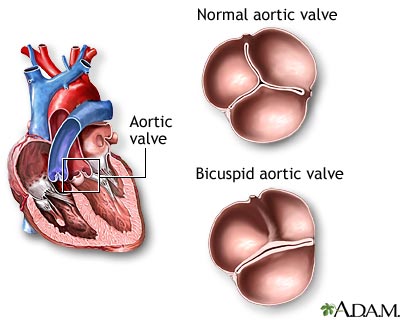Alternate Names : Bicommissural aortic valve
Definition
A bicuspid aortic valve is an aortic valve that only has two leaflets, instead of three.
The aortic valve regulates blood flow from the heart into the aorta, the major blood vessel that brings blood to the body.
Overview, Causes, & Risk Factors
The aortic valve allows oxygen-rich blood to flow from the heart to the aorta. It prevents the blood from flowing back from the aorta into the heart when the pumping chamber relaxes.
Bicuspid aortic valve is present at birth (congenital). An abnormal aortic valve develops during the early weeks of pregnancy, when the baby’s heart develops. The cause of this problem is unclear, but it is the most common congenital heart disease. It often runs in families.
The bicuspid aortic valve allows leakage of blood back into the pumping chamber (aortic regurgitation). The aortic valve may also become stiff and not open up as well (aortic stenosis). The aorta may become enlarged with this condition.
This condition is more common among males than females.
A bicuspid aortic valve often exists in babies with coarctation of the aorta and other diseases in which there is a blockage to the left side of the heart.
Pictures & Images
Bicuspid aortic valve
 A bicuspid aortic valve is an aortic valve that only has two leaflets, instead of three. The aortic valve allows oxygen-rich blood to flow from the heart to the aorta. It prevents the blood from flowing back from the aorta into the heart. An abnormal aortic valve develops during the early weeks of pregnancy, when the baby’s heart develops.
A bicuspid aortic valve is an aortic valve that only has two leaflets, instead of three. The aortic valve allows oxygen-rich blood to flow from the heart to the aorta. It prevents the blood from flowing back from the aorta into the heart. An abnormal aortic valve develops during the early weeks of pregnancy, when the baby’s heart develops.
-
Bicuspid aortic valve : Overview, Causes, & Risk Factors
-
Bicuspid aortic valve : Symptoms & Signs, Diagnosis & Tests
-
Bicuspid aortic valve : Treatment



Review Date : 4/30/2008
Reviewed By : Mark A Fogel, MD, FACC, FAAP, Associate Professor of Pediatrics and Radiology, Director of Cardiac MR, The Children’s Hospital of PhiladelphiaDivision of Cardiology, Philadelphia, PA. Also reviewed by David Zieve, MD, MHA, Medical Director, A.D.A.M., Inc.
